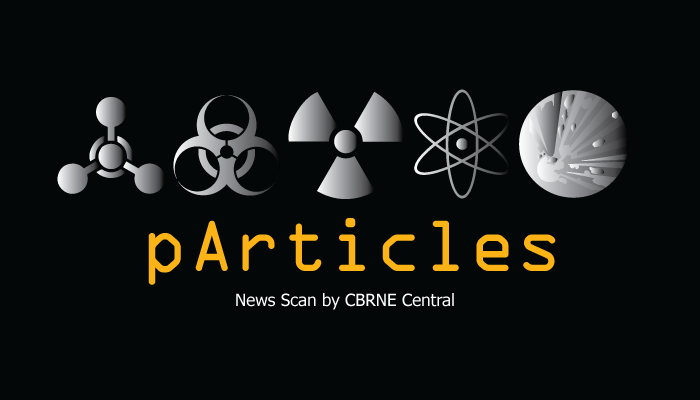Topics in this issue of CBRNE Particles include collapse of a tunnel storing radioactive materials at Hanford, Chemical Facility Anti-Terrorism Standards quarterly update, and how the IED won.
In This Article
RADIOLOGICAL + NUCLEAR
Tunnel Collapses at Hanford Nuclear Waste Site in Washington State
Hundreds of workers at the Department of Energy’s Hanford nuclear site in Washington state had to “take cover” Tuesday morning after the collapse of 20-foot-long portion of a tunnel used to store contaminated radioactive materials. The tunnel is one of two that run into the Plutonium Uranium Extraction Facility, also known as PUREX. Officials state there was “no indication of a release of contamination at this point” but that crews were still testing the area. Responders also were using a robot to take video and survey the damage. Washington Post >>
Thousands of Hanford Workers Take Cover After Cave-In of Tunnel
Thousands of workers at the Hanford nuclear reservation in Richland were forced to take cover indoors after a tunnel containing radioactive waste collapsed Tuesday morning, government officials said. Nearly 4,800 workers at the nuclear site were told to shelter indoors, an Energy Department spokeswoman said. At around noon Tuesday, workers outside of the facility where the cave-in occurred were cleared and sent home early. Seattle Times >>
LANL Reports Fire at Plutonium Facility
A small fire broke out in Los Alamos National Laboratory’s plutonium facility Wednesday and caused minor injuries, but a lab spokesman said no radioactive materials were involved in the incident. Lab spokesman Kevin Roark said the blaze involved a pyrophoric metal material, which can spontaneously overheat in the presence of oxygen, but it was quickly put out. Albuquerque Journal >>
Plutonium Research to Aid Nuclear Cleanup Techniques
Researchers at Florida State University have discovered a plutonium-organic hybrid compound that doesn’t behave as expected. The compound behaves as if it composed of lighter elements such as iron or nickel. The discovery could yield new technologies and methods for cleaning up nuclear waste.
Nuke Waste Debate: Turn it Into Glass or Encase in Cement?
Congress should consider authorizing the U.S. Department of Energy to study encasing much of the nuclear waste at the nation’s largest waste repository in a cement-like mixture instead of turning it into glass logs, according to a new report from the U.S. Government Accountability Office. Chem.info >>
POLICY + POLITICS
Chemical Facility Anti-Terrorism Standards (CFATS) Quarterly Update
To date, approximately 12,000 updated Top-Screens have been received from the 27,000 facilities that previously reported holdings of chemicals of interest (COI) at or above the screening threshold quantity. DHS has sent out over 10,000 tiering determination letters to facilities that have submitted new Top-Screens, prioritized based on when DHS received the facility Top-Screen, upcoming compliance inspection schedules, and to take into account workload for submitters that have a high number of covered facilities with changes. DHS >>
North Korea Accuses CIA of ‘Bio-Chemical’ Plot Against Leadership
North Korea on Friday accused the U.S. Central Intelligence Agency and South Korea’s intelligence service of a plot to attack its “supreme leadership” with a bio-chemical weapon and said such a “pipe-dream” could never succeed. Tension on the Korean peninsula has been high for weeks, driven by concern that North Korea might conduct its sixth nuclear test or test-launch another ballistic missile in defiance of U.N. Security Council resolutions. Reuters >>
U.S. Nuclear Weapons Lab to Keep Focus on National Security
Scientists and researchers at the federal government’s largest national laboratory are pushing ahead with work related to national security and the proliferation of nuclear weapons as new managers take over New Mexico-based Sandia National Laboratories for the first time in decades, officials said Monday. Director Stephen Younger discussed the lab’s future during a news conference that marked the start of a new contract with National Technology and Engineering Solutions of Sandia, a subsidiary of Honeywell International. Seattle Times >>
U.S. Sanctions Chemists for Gas Attack on Civilians in Syria
The Trump Administration imposed economic sanctions against Syrian government chemists and other scientists on April 24 for their role in the alleged sarin gas attack in early April that killed dozens of people. The sanctions were leveled against 271 employees of the Scientific Studies & Research Center, the Syrian government body the U.S. believes is responsible for developing and producing chemical and biological weapons. C&EN >>
EOD, C-IED + MINE CLEARANCE
How the IED Won: Dispelling the Myth of Tactical Success and Innovation
As roadside bombs began to cause a majority of U.S. casualties, counter-IED efforts sought to defeat the IED’s strategic influence. Significant U.S. military investment and innovation to counter IEDs succeeded in improving the odds for American forces in any single engagement with the devices. At scale, however, these innovations imposed higher costs on U.S. forces even as the bombs got cheaper. And while these innovations reduced risk to U.S. forces, they did not change the way in which the devices challenged military objectives in the conflicts. In a protracted fight in IED-laden ground, the initiative remains with the bomb builder. War on the Rocks >>
Commando-Style Heist in Paraguay Involved 16 Car Bombs
Paraguay’s Ciudad del Este witnessed scenes reminiscent of war as several dozen heavily armed men undertook a sophisticated and lethal heist operation, which authorities have blamed on Brazil’s most powerful crime group. Between 50 and 60 individuals armed with military-grade weapons and explosives attacked a transportation company just after midnight on April 24 in Ciudad del Este, a town close to the so-called “Tri-Border” region where Paraguay, Brazil and Argentina meet, according to Paraguay’s National Police. War Is Boring >>
Watchdog Says Yemen Rebel Land Mines Killed, Maimed Hundreds
An international rights group on Thursday decried the use of land mines by Yemen’s Shiite rebels in the impoverished Arab country at war, saying they have killed and maimed hundreds of civilians and prevented many of the displaced from returning to their homes. ABC News >>
CHEMICAL WEAPONS + SAFETY
System Successfully Turns Deadly Chemicals into Dirt
A DARPA program that is developing a field-deployable system for onsite neutralization of bulk stores of chemical warfare agents has successfully demonstrated a novel waterless soil-scrubbing technology that safely neutralized toxic chemicals simulating sarin, soman, and mustard agents. Created under the Agency’s Agnostic Compact Demilitarization of Chemical Agents (ACDC) program, the technology demonstrated greater than 99.9999% removal of the simulants, without creating any hazardous waste by-products. Armed with Science >>
NATO Welcomes 20th Anniversary of Chemical Weapons Convention
NATO marked the anniversary on 29 April. In a letter from Secretary General Jens Stoltenberg to Ambassador Ahmet Üzümcü, Director-General of the Organisation for the Prohibition of Chemical Weapons (OPCW), Stoltenberg praised the OPCW’s work, noting that 94% of all declared chemical weapons worldwide have been eliminated under their monitoring over the past 20 years, with the remainder to be destroyed within six years. NATO >>
How Investigators Figure Out What Chemical Weapons Are Used — And Who Used Them
France said its researchers used evidence such as blood samples from exposed to the nerve agent in Khan Sheikhoun as well as analysis from items carried from the village. The report said it found hexamine, a hallmark of sarin produced by the Syrian government. Washington Post >>
Soviet-Era Bomb Used In Syria Chemical Weapon Attack, Claims Rights Group
The Syrian government most likely used a Soviet-made weapon containing the nerve agent sarin in an April 4 attack on the town of Khan Sheikhoun, according to an investigation by Human Rights Watch. The alleged attack on Khan Sheikhoun resulted in the deaths of more than 92 people, including 25 members of a single family. Foreign Policy >>
April Nerve Gas Attack in Syria Appears to Be One in a Series
Last month’s chemical weapons attack on a rebel-held Syrian town may have caught the world’s — and President Trump’s — attention, but it was not the only recent suspected use of a nerve agent by Syrian government forces. New information about the additional attacks appears in a Human Rights Watch report released Monday, bolstering New York Times reporting on those episodes and placing Khan Sheikhoun in the context of wider evidence that the Syrian government continues to use chemical weapons despite its 2013 agreement to give them up. NY Times >>
Echoes of the Past: Syria, Chemical Weapons, and Civilian Targeting
Regime supporters have stubbornly attempted to cast doubt on the idea that the Syrian government was responsible, or even that a chemical attack took place at all. Al Masdar News, a pro-regime news organization, initially announced that the attack was the result of Syrian aircraft bombing a rebel rocket production facility. Syrian President Bashar al Assad, for his part, asserted that the chemical attack was staged, a charge soon echoed by Russian President Vladimir Putin. War on the Rocks >>
ADF Selects Gas-Detection System
The Australian Defence Force has selected Bertin Technologies’ Second Sight MS chemical threat standoff detector for the Australian Army. The Second Sight MS is a remote gas-detection system that uses a real-time infrared sensor to detect threats such as chemical warfare agents or toxic industrial gas clouds at ranges of up to 5km. Shepard Media >>
HEALTH + SAFETY
The US Military Has a New Technology to Finally Solve the Concussion Crisis
Since 2010, there have been more than 361,000 service members diagnosed with some form of traumatic brain injury, according to the US Defense Department’s Defense and Veterans Brain Injury Center. A new sensor technology that could give medics on the battlefield a clearer idea of whether or not an injury actually occurred after a blast. The coin-sized sensors, placed in service members’ helmets and tactical gear, detect the impact of a blast wave. Defense One >>
Help Us Beat Firefighter Cancer!
As the number of firefighters and their families affected by occupational cancer steadily increases, improving education, prevention measures and support are imperative. As part of this effort, the Fire Service Occupational Cancer Alliance (FSOCA) is hosting the Fire Service Occupational Cancer Symposium in Phoenix, Arizona September 7-8, 2017. Everyone Goes Home >>
HISTORICAL REFLECTIONS
Blasts from the Past: Old Nuke Test Films Offer New Insights
Between 1945 and 1962 the U.S. conducted more than 200 atmospheric nuclear weapon tests and captured the detonations on film. Multiple cameras capable of recording 2,400 frames per second covered each blast, creating a highly technical record of the U.S. nuclear arsenal—and a visual deterrent against its use. Scientific American >>
The Nobel Laureate Who Pioneered Chemical Warfare
Few historical figures have a more complicated legacy than Fritz Haber. The German-born chemist won a Nobel Prize for his synthesis of ammonia, a groundbreaking process that transformed agriculture and eventually saved millions of lives. Yet by the time Haber received the award in 1919, he had been widely denounced as a mass murderer for his other major scientific project—developing poison gas for Germany during World War I. History.com >>
In 1943, America Killed Its Own Troops with Poison Gas
The American Liberty ship John Harvey. That blandly named vessel carried one hundred tons of mustard gas, contained in hundred-pound bombs, which the United States had sent to the Mediterranean in case Hitler unleashed chemical weapons in a last desperate bid to stave off the invasion of Fortress Europe. National Interest >>
How the U.S. Prepared for Nuclear Catastrophe
In a new book exploring United States officials’ detailed doomsday plans during the Cold War, writer and historian Garrett Graff presents a look at how nuclear disaster preparation shaped the modern world. Raven Rock: The Story of the U.S. Government’s Secret Plan to Save Itself—While the Rest of Us Die, released May 2, recounts the history of “how nuclear war would have actually worked — the nuts and bolts of war plans, communication networks, weapons, and bunkers — and how imagining and planning for the impact of nuclear war actually changed.” TIME >>
SPECIAL INTEREST
How to Survive the First Hour of a Nuclear Attack
So let’s say one of the worst-case scenarios from one of those government models did happen, and somehow a 10 KT nuclear bomb was detonated without the US having advance warning. Here’s a timeline of how that nightmare would likely play out in a major city like New York or Washington DC—and your odds of making it out alive. Tonic >>
Call for Papers: International Conference on Radiation Protection in Medicine
Interested participants have until June 15 to submit an abstract to present at the IAEA International Conference on Radiation Protection in Medicine – Achieving Change in Practice, to be held in Vienna, Austria, from 11-15 Dec 2017. The conference is directed at a wide audience with an interest in radiation protection in medicine, from health professionals and health researchers to academics and regulators. IAEA >>
DOJ Request for Input on Advancing Forensic Science
The Department of Justice has requested public comment on how the Department should move forward to evaluate and improve the underlying science of forensic evidence, improve the operational management systems of forensic science service providers, and improve the understanding of forensic science by legal practitioners. Written comments should be submitted by June 9, 2017. AAFS >>


